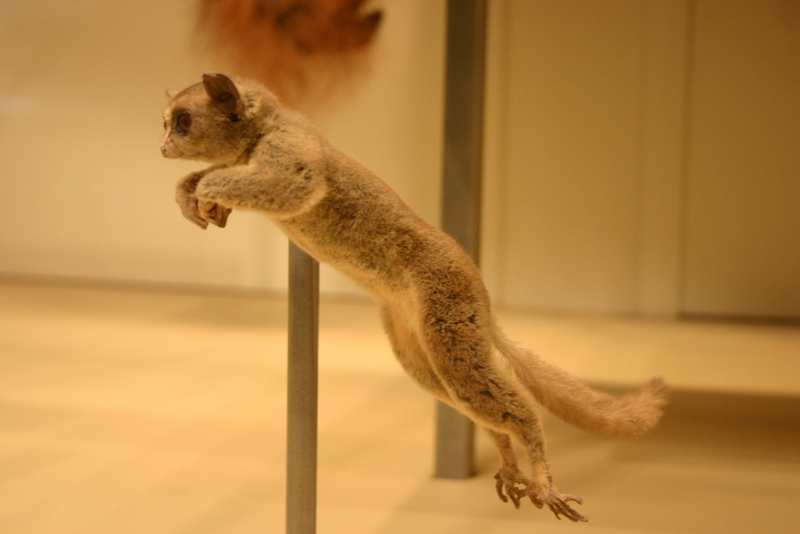|
| Query: apes and monkeys | Result: 17th of 48 | |
Galago (Family: Galagidae) - Wiki
| Subject: | Galago (Family: Galagidae) - Wiki
| |

| Resolution: 1024x683
File Size: 218180 Bytes
Upload Date: 2008:01:15 13:36:09
|
Galago
From Wikipedia, the free encyclopedia
Scientific classification
Kingdom: Animalia
Phylum: Chordata
Class: Mammalia
Order: Primates
Suborder: Strepsirrhini
Infraorder: Lorisiformes
Family: Galagidae Gray, 1825
Genera: Otolemur, Euoticus, Galago
[Photo] South African Galago; Mohol Bushbaby (Galago moholi). Source: Flickr (www.flickr.com/photos/14405058@N08/2169892170/). Author: ideonexus (http://ideonexus.com/).
Galagos, also known as bushbabies, bush babies or nagapies (meaning "little night monkeys" in Afrikaans), are small, nocturnal primates native to continental Africa, and make up the family Galagidae. They are sometimes included as a subfamily within the Lorisidae or Loridae.
According to some accounts, the name bush baby comes from either from the animals' cries, or their appearance. The South African Afrikaans name "nagapie" (little night monkey), comes from the fact that they are almost exclusively seen at night.
Characteristics
Galagos are agile leapers and run swiftly along branches. They have large eyes that give them good night vision, strong hind limbs, acute hearing, and long tails that help them balance. They have nails on most of their digits, except for the second toe of the hindfoot, which bears a 'toilet' claw for grooming. Their diet is a mixture of insects and other small animals, fruit, and tree gums. They have pectinate ("comb-like") incisors, and the dental formula:
2.1.3.3
2.1.3.3
After a gestation period of 110-133 days, young galagos are born with half-closed eyes and are initially unable to move about independently. After a few days, the mother carries the infant in her mouth, and places it on branches while feeding.
Females maintain their territory but share them with their offspring. Males leave their mothers' territories after puberty but females remain, forming social groups consisting of closely related females and their young. Adult males maintain separate territories, which overlap with those of the female social groups; generally, one adult male mates with all the females in an area. Males who have not established such territories sometimes form small bachelor groups.
While their keeping as pets is not advised (like many other non-human primates, they are considered likely sources of zoonoses, diseases that can cross species barriers) it is certainly done. Equally, they're highly likely to attract attention from customs officials on importation into many countries. Reports from veterinary and zoological sources indicate captive lifetimes of 12 to 16.5 years, suggesting a natural lifetime of the order of a decade.
Galagos communicate both by calling to each other, and by marking their paths with urine. At the end of the night, group members use a special rallying call and gather to sleep in a nest made of leaves, a group of branches, or a hole in a tree.
Classification
There has been much recent study of the Galagonidae. Several new species have been discovered, and they are now grouped into three genera, with the two former members of the now defunct genus Galagoides returned to their original genus Galago:
ORDER PRIMATES
Suborder Strepsirrhini: non-tarsier prosimians
Family Cheirogaleidae: dwarf and mouse lemurs
Family Lemuridae: lemurs
Family Lepilemuridae: sportive lemurs
Family Indriidae: wooly lemurs and allies
Family Daubentoniidae: Aye-aye
Family Lorisidae: lorises, pottos and allies
Family Galagidae: galagos, or bushbabies
Genus Otolemur : greater galagos, or thick-tailed bushbabies
- Brown Greater Galago, Otolemur crassicaudatus
- Silvery Greater Galago, Otolemur monteiri
- Northern Greater Galago, Otolemur garnettii
Genus Euoticus : needle-clawed bushbabies
- Southern Needle-clawed Bushbaby, Euoticus elegantulus
- Northern Needle-clawed Bushbaby, Euoticus pallidus
Genus Galago : lesser galagos, or lesser bushbabies
- Senegal Bushbaby, Galago senegalensis
- Mohol Bushbaby, Galago moholi
- Somali Bushbaby, Galago gallarum
- Dusky Bushbaby, Galago matschiei
- Bioko Allen's Bushbaby, Galago alleni
- Cross River Bushbaby, Galago cameronensis
- Gabon Bushbaby, Galago gabonensis
- Zanzibar Bushbaby, Galago zanzibaricus
- Grant's Bushbaby, Galago granti
- Malawi Bushbaby, Galago nyasae
- Uluguru Bushbaby, Galago orinus
- Rondo Bushbaby, Galago rondoensis
- Prince Demidoff's Bushbaby, Galago demidoff
- Thomas's Bushbaby, Galago thomasi
Suborder Haplorrhini: tarsiers, monkeys and apes
Genomics
A low-coverage genomic sequence of the Northern Greater Galago, Otolemur garnettii, is in progress. As a 'primitive' primate, the sequence will be particularly useful in bridging the sequences of higher primates (macaque, chimp, human) to close non-primates such as rodents. The 2x planned coverage will not be sufficient to create a full genome assembly, but will provide comparative data across most of the human assembly.
http://en.wikipedia.org/wiki/Galago
| The text in this page is based on the copyrighted Wikipedia article shown in above URL. It is used under the GNU Free Documentation License. You may redistribute it, verbatim or modified, providing that you comply with the terms of the GFDL. |
|
^o^
Animal Pictures Archive for smart phones
^o^
|
|